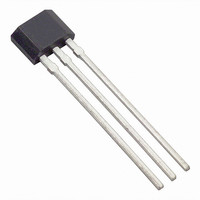US1881EUA Melexis Inc, US1881EUA Datasheet - Page 14

US1881EUA
Manufacturer Part Number
US1881EUA
Description
IC LATCH CMOS MP TO-92UA
Manufacturer
Melexis Inc
Type
Bipolar Latchr
Specifications of US1881EUA
Sensing Range
9.5mT Trip, -9.5mT Release
Voltage - Supply
3.5 V ~ 24 V
Current - Supply
5mA
Current - Output (max)
50mA
Output Type
Digital, Open Drain
Operating Temperature
-40°C ~ 85°C
Package / Case
TO-92UA
Lead Free Status / RoHS Status
Lead free / RoHS Compliant
Features
-
A magnet in a closed high permeability magnetic circuit (an iron bar connecting the north to the south pole)
will operate at or near the Br value. A magnet with no pole pieces will operate with a flux density down the
demagnetization curve from the Br value, how far down is dependant on the aspect ratio or the ratio of the
length to the diameter. Short wide magnets will generate lower flux than tall skinny magnets of the same vol-
ume.
The concept of the load line and the operating point on the demagnetization curve will influence many magnet-
ic parameters. These include the flux density available to actuate a sensor and the reversible temperature coeffi-
cient.
Temperature Effects
Graphical representations are often used to determine the operating point on the demagnetization curve.
Temperature effects on permanent magnets are dependent on the type of material considered. Manufacturers will
specify various figures of merit to describe the temperature performance of magnet materials. Among these are
the Reversible losses that are represented by Tc. The term refers to the losses in the Br and the Hc. A calcula-
tion can show that for every incremental change in temperature the magnet will lose a proportion of its strength.
This loss will be recovered completely so long as the temperature does not exceed the Tmax or maximum prac-
tical operating temperature in air. The Tmax value is dependent on the magnets operating point on the demag-
netization curve. A magnet operating closer to Br can have a higher Tmax. Irreversible losses are described as
losses that can only be recovered by re-magnetizing the sample to saturation with an electromagnetic field. These
losses occur when the operating point falls below the "knee" on the demagnetization curve. This can occur due
to temperature and inefficient magnetic circuit design. An important feature of magnet materials is the Curie tem -
perature, TCurie,. This is a temperature at which the metallurgical properties of the sample are adversely effect
ed. In most applications the ambient temperature can never approach the Curie temperature without completely
destroying the electronic components first.
Losses Over Time
Time has minimal effect on the strength of permanent magnets. Long term studies in the industry have shown
that at 100,000 hours the losses for Rare Earth Samarium Cobalt magnets were essentially zero and for Alnico
5 were less than 3%. In the case of Rare Earth Neodymium materials the losses are compounded by internal cor-
rosion.
Corrosion & Coatings
It is often necessary to provide coatings to these materials to minimize the corrosion that results from the Iron
content. We lay-people refer to this stuff as rust. The options for coatings include epoxies, zinc and nickel. The
best of these is nickel however it is slightly magnetic and marginally reduces the available field. Coatings can
also be useful with Rare Earth Samarium to minimize "spalling" or the fracture of tiny slivers from the corners
of this brittle, hard material.
In many sensor applications these characteristics are of little significance but as with all engineering tasks it is
up to the design engineer to know what can safely be ignored and what must be consider for the projects suc-
cess.
Many texts are available to aid in a complete understanding of magnets. The Magnetic Material Producers
Association is a trade group that establishes and maintains standards for basic grades and classes of materials.
Their reference booklets are an excellent source for detailed technical data on the various generic classes of mate
rials. Certain manufacturers also provide excellent databooks with helpful applications and design sections.
These include Arnold Engineering Company, Magnet Sales & Manufacturing, Magnetfabrik Schramberg,
Hitachi Metals; Magnetic Materials Division and Widia Magnettechnik.


















